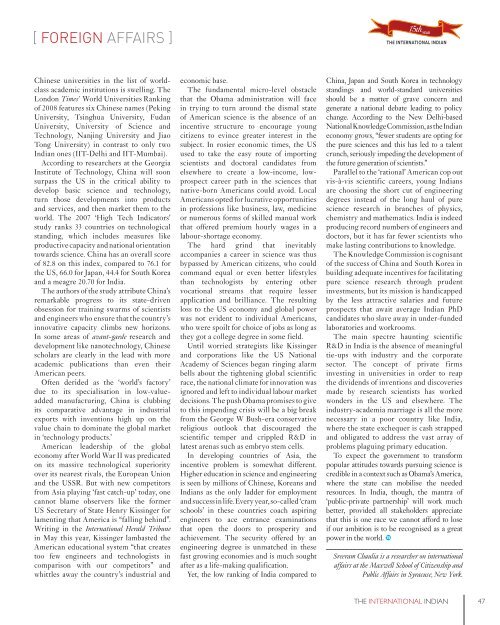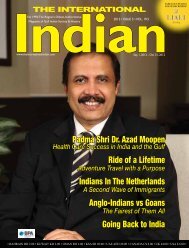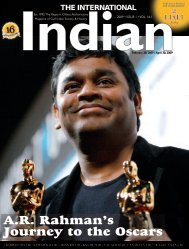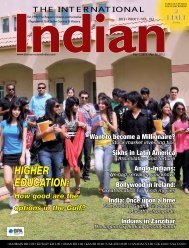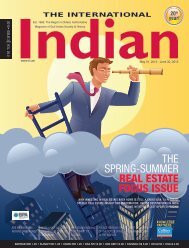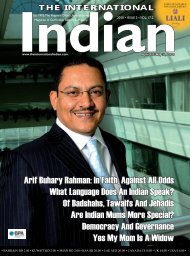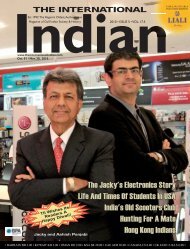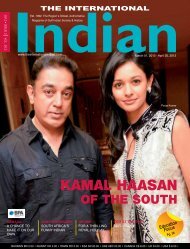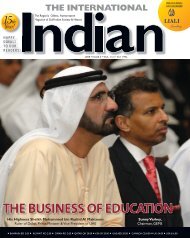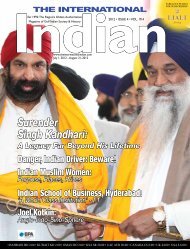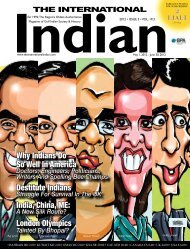THE INTERNATIONAL - International Indian
THE INTERNATIONAL - International Indian
THE INTERNATIONAL - International Indian
You also want an ePaper? Increase the reach of your titles
YUMPU automatically turns print PDFs into web optimized ePapers that Google loves.
[ FOREIGN AFFAIRS ]<br />
Chinese universities in the list of worldclass<br />
academic institutions is swelling. The<br />
London Times’ World Universities Ranking<br />
of 2008 features six Chinese names (Peking<br />
University, Tsinghua University, Fudan<br />
University, University of Science and<br />
Technology, Nanjing University and Jiao<br />
Tong University) in contrast to only two<br />
<strong>Indian</strong> ones (IIT-Delhi and IIT-Mumbai).<br />
According to researchers at the Georgia<br />
Institute of Technology, China will soon<br />
surpass the US in the critical ability to<br />
develop basic science and technology,<br />
turn those developments into products<br />
and services, and then market them to the<br />
world. The 2007 ‘High Tech Indicators’<br />
study ranks 33 countries on technological<br />
standing, which includes measures like<br />
productive capacity and national orientation<br />
towards science. China has an overall score<br />
of 82.8 on this index, compared to 76.1 for<br />
the US, 66.0 for Japan, 44.4 for South Korea<br />
and a meagre 20.70 for India.<br />
The authors of the study attribute China’s<br />
remarkable progress to its state-driven<br />
obsession for training swarms of scientists<br />
and engineers who ensure that the country’s<br />
innovative capacity climbs new horizons.<br />
In some areas of avant-garde research and<br />
development like nanotechnology, Chinese<br />
scholars are clearly in the lead with more<br />
academic publications than even their<br />
American peers.<br />
Often derided as the ‘world’s factory’<br />
due to its specialisation in low-valueadded<br />
manufacturing, China is clubbing<br />
its comparative advantage in industrial<br />
exports with inventions high up on the<br />
value chain to dominate the global market<br />
in ‘technology products.’<br />
American leadership of the global<br />
economy after World War II was predicated<br />
on its massive technological superiority<br />
over its nearest rivals, the European Union<br />
and the USSR. But with new competitors<br />
from Asia playing ‘fast catch-up’ today, one<br />
cannot blame observers like the former<br />
US Secretary of State Henry Kissinger for<br />
lamenting that America is “falling behind”.<br />
Writing in the <strong>International</strong> Herald Tribune<br />
in May this year, Kissinger lambasted the<br />
American educational system “that creates<br />
too few engineers and technologists in<br />
comparison with our competitors” and<br />
whittles away the country’s industrial and<br />
economic base.<br />
The fundamental micro-level obstacle<br />
that the Obama administration will face<br />
in trying to turn around the dismal state<br />
of American science is the absence of an<br />
incentive structure to encourage young<br />
citizens to evince greater interest in the<br />
subject. In rosier economic times, the US<br />
used to take the easy route of importing<br />
scientists and doctoral candidates from<br />
elsewhere to create a low-income, lowprospect<br />
career path in the sciences that<br />
native-born Americans could avoid. Local<br />
Americans opted for lucrative opportunities<br />
in professions like business, law, medicine<br />
or numerous forms of skilled manual work<br />
that offered premium hourly wages in a<br />
labour-shortage economy.<br />
The hard grind that inevitably<br />
accompanies a career in science was thus<br />
bypassed by American citizens, who could<br />
command equal or even better lifestyles<br />
than technologists by entering other<br />
vocational streams that require lesser<br />
application and brilliance. The resulting<br />
loss to the US economy and global power<br />
was not evident to individual Americans,<br />
who were spoilt for choice of jobs as long as<br />
they got a college degree in some field.<br />
Until worried strategists like Kissinger<br />
and corporations like the US National<br />
Academy of Sciences began ringing alarm<br />
bells about the tightening global scientific<br />
race, the national climate for innovation was<br />
ignored and left to individual labour market<br />
decisions. The push Obama promises to give<br />
to this impending crisis will be a big break<br />
from the George W Bush-era conservative<br />
religious outlook that discouraged the<br />
scientific temper and crippled R&D in<br />
latest arenas such as embryo stem cells.<br />
In developing countries of Asia, the<br />
incentive problem is somewhat different.<br />
Higher education in science and engineering<br />
is seen by millions of Chinese, Koreans and<br />
<strong>Indian</strong>s as the only ladder for employment<br />
and success in life. Every year, so-called ‘cram<br />
schools’ in these countries coach aspiring<br />
engineers to ace entrance examinations<br />
that open the doors to prosperity and<br />
achievement. The security offered by an<br />
engineering degree is unmatched in these<br />
fast growing economies and is much sought<br />
after as a life-making qualification.<br />
Yet, the low ranking of India compared to<br />
China, Japan and South Korea in technology<br />
standings and world-standard universities<br />
should be a matter of grave concern and<br />
generate a national debate leading to policy<br />
change. According to the New Delhi-based<br />
National Knowledge Commission, as the <strong>Indian</strong><br />
economy grows, “fewer students are opting for<br />
the pure sciences and this has led to a talent<br />
crunch, seriously impeding the development of<br />
the future generation of scientists.”<br />
Parallel to the ‘rational’ American cop out<br />
vis-à-vis scientific careers, young <strong>Indian</strong>s<br />
are choosing the short cut of engineering<br />
degrees instead of the long haul of pure<br />
science research in branches of physics,<br />
chemistry and mathematics. India is indeed<br />
producing record numbers of engineers and<br />
doctors, but it has far fewer scientists who<br />
make lasting contributions to knowledge.<br />
The Knowledge Commission is cognisant<br />
of the success of China and South Korea in<br />
building adequate incentives for facilitating<br />
pure science research through prudent<br />
investments, but its mission is handicapped<br />
by the less attractive salaries and future<br />
prospects that await average <strong>Indian</strong> PhD<br />
candidates who slave away in under-funded<br />
laboratories and workrooms.<br />
The main spectre haunting scientific<br />
R&D in India is the absence of meaningful<br />
tie-ups with industry and the corporate<br />
sector. The concept of private firms<br />
investing in universities in order to reap<br />
the dividends of inventions and discoveries<br />
made by research scientists has worked<br />
wonders in the US and elsewhere. The<br />
industry-academia marriage is all the more<br />
necessary in a poor country like India,<br />
where the state exchequer is cash strapped<br />
and obligated to address the vast array of<br />
problems plaguing primary education.<br />
To expect the government to transform<br />
popular attitudes towards pursuing science is<br />
credible in a context such as Obama’s America,<br />
where the state can mobilise the needed<br />
resources. In India, though, the mantra of<br />
‘public-private partnership’ will work much<br />
better, provided all stakeholders appreciate<br />
that this is one race we cannot afford to lose<br />
if our ambition is to be recognised as a great<br />
power in the world.<br />
Sreeram Chaulia is a researcher on international<br />
affairs at the Maxwell School of Citizenship and<br />
Public Affairs in Syracuse, New York.<br />
<strong>THE</strong> <strong>INTERNATIONAL</strong> INDIAN 47


